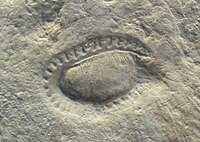
Back الانفجار الأفالوني Arabic Pagbutong Avalon CEB Avalonská exploze Czech Explosión de Avalon Spanish Explosion d'Avalon French Letusan Avalon ID Letupan Avalon Malay Eksplozja Avalon Polish Авалонский взрыв Russian 阿瓦隆大爆发 Chinese




The Avalon explosion, named from the Precambrian faunal trace fossils discovered on the Avalon Peninsula in Newfoundland, eastern Canada, is a proposed evolutionary radiation of prehistoric animals about 575 million years ago in the Ediacaran period, with the Avalon explosion being one of three eras grouped in this time period.[3] This evolutionary event is believed to have occurred some 33 million years earlier than the Cambrian explosion, which had been long thought to be when complex life started on Earth.
Scientists are still unsure of the full extent behind the development of the Avalon explosion,[3] which resulted in a rapid increase in metazoan biodiversity, including the first appearance of some extant infrakingdoms/superphyla such as cnidarians and bilaterians. Many of the Avalon explosion animals are sessile soft-bodied organisms living in deep marine environments,[4] and the first stages of the Avalon explosion were observed through comparatively minimal species.[3]
- ^ Porter, S.M. (1 June 2007). "Seawater Chemistry and Early Carbonate Biomineralization". Science. 316 (5829): 1302. Bibcode:2007Sci...316.1302P. doi:10.1126/science.1137284. PMID 17540895. S2CID 27418253.
- ^ Wade, M. (1972). "Hydrozoa and Scyphozoa and other medusoids from the Precambrian Ediacara fauna, South Australia" (PDF). Palaeontology. 15: 197–225. Archived from the original (PDF) on 9 April 2011.
- ^ a b c Cite error: The named reference
Shen2007was invoked but never defined (see the help page). - ^ Cite error: The named reference
:0was invoked but never defined (see the help page).